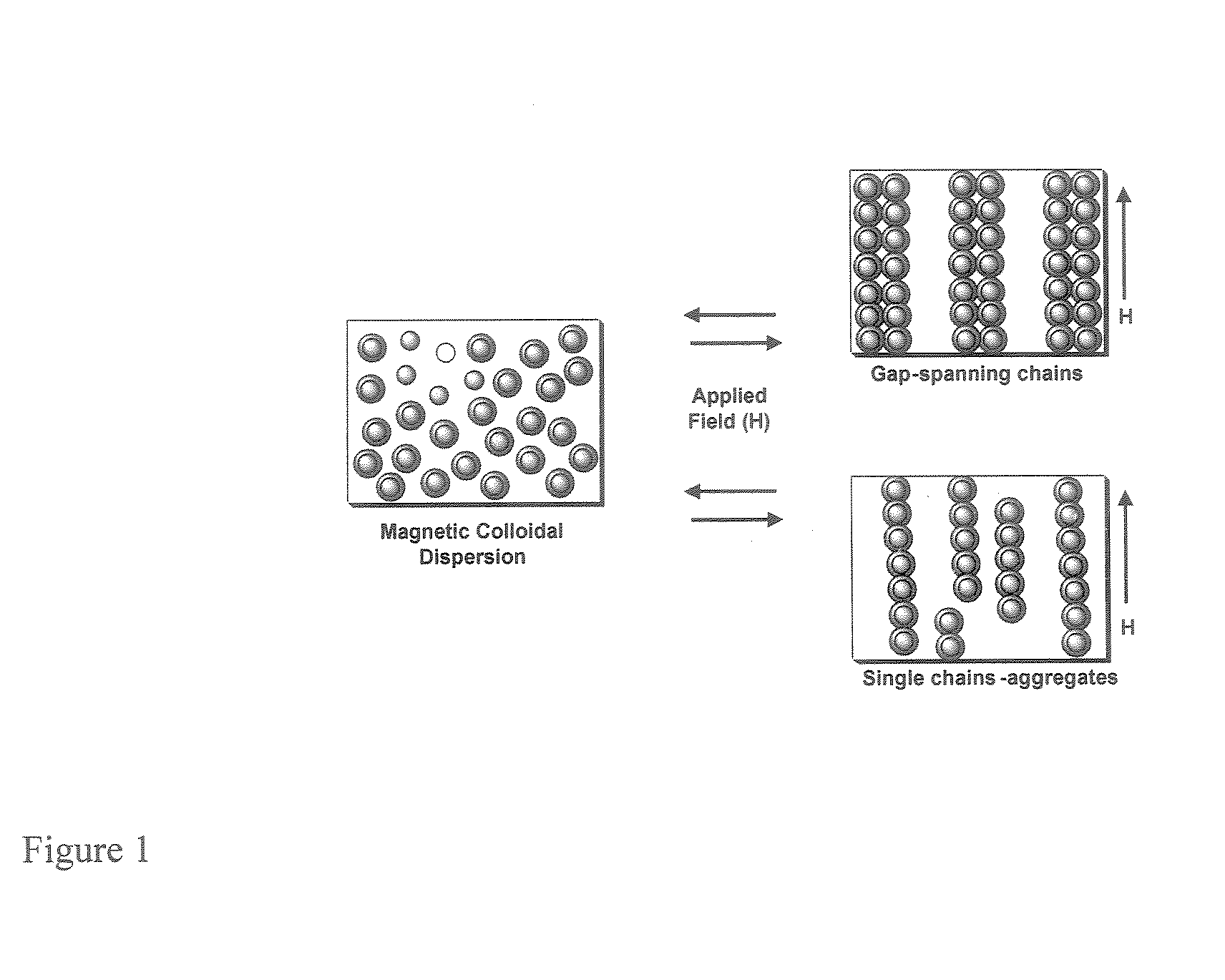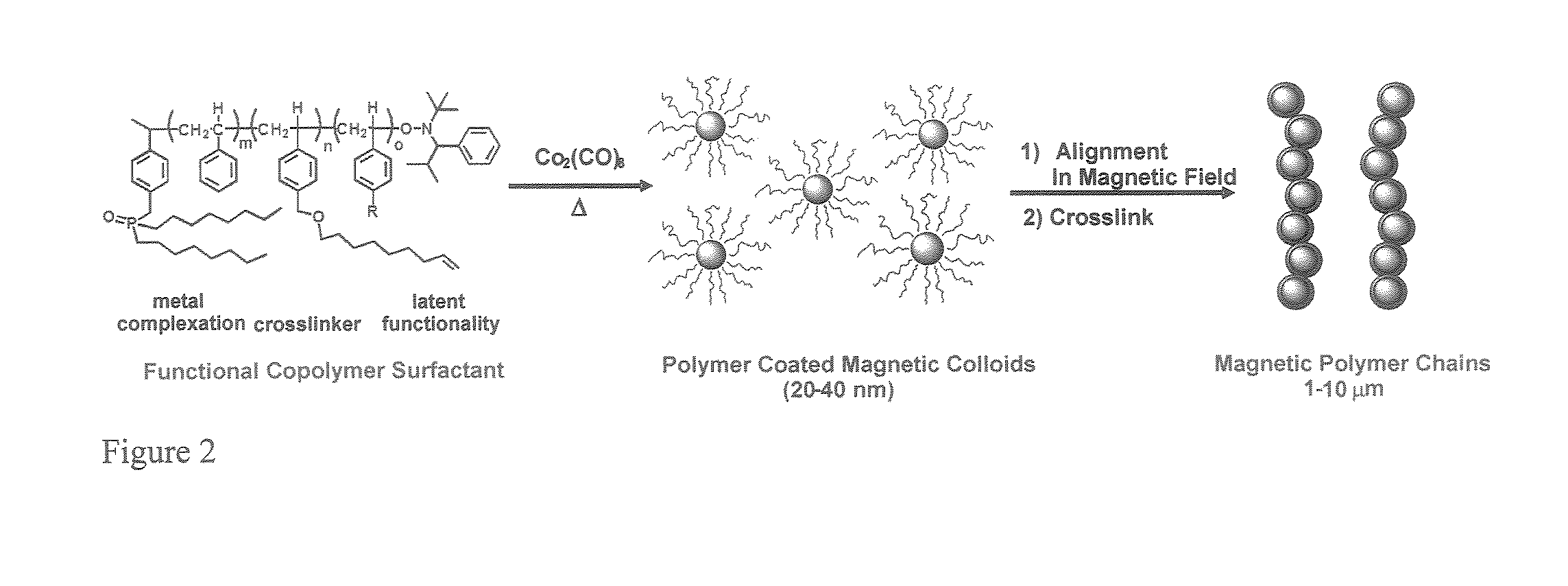Multifunctional polymer coated magnetic nanocomposite materials
a magnetic nanocomposite material and multi-functional technology, applied in the field of polymer coated metallic nanoparticles, can solve the problems of inability to fully functionalize colloidal surfaces, inability to perform robust synthetic methods to functionalize colloidal surfaces, and inability to explore nanoscale building blocks using smaller magnetic colloids (particle size100 nm) coated with organic polymer shells. self-assembling organization and field-induced magnetic nanoparticles to achieve permanent linkage chains
- Summary
- Abstract
- Description
- Claims
- Application Information
AI Technical Summary
Benefits of technology
Problems solved by technology
Method used
Image
Examples
example 1
[0231]demonstrates the viability of controlled / living radical techniques as a route to prepare functional copolymer surfactants for cobalt nanoparticles.
example 2
[0232]The preparation of polymer coated ferromagnetic nanoparticles is more challenging as high temperature annealing steps are often required to convert superparamagnetic colloids into ferromagnetic phases (Sun, S.; Murray, C. B. J. Appl. Plays. 1999, 85, (8, Pt. 2A), 4325-4330). A few examples of polymer coated ferromagnetic nanoparticles of metallic cobalt (Co) (Thomas, J. R. J. Appl Phys, 1966, 37, (7), 2914-15. (b) Safran, S. A., Nature Materials 2003, 2, (2), 71-72; Platonova, O. A.; Bronstein, L. M.; Solodovnikov, S. P.; Yanovskaya, I. M.; Obolonkova, E. S.; Valetsky, P. M.; Wenz, E.; Antonietti, M. Colloid Polym. Sci. 1997, 275, (5), 426-431), or iron have been reported, however, methodologies to synthesize well-defined nanocomposite colloids of uniform size and tunable magnetic properties have not been extensively developed.
[0233]The synthesis and characterization of polymer coated ferromagnetic nanoparticles that organize into extended one-dimensional assemblies is describ...
example 3
[0239]The preparation of magnetic nanoparticles composed of cobalt colloidal cores and organic copolymer shells is described. Controlled radical polymerizations were used to synthesize block and random copolymers incorporating different functional ligands with varying binding affinity to cobalt nanoparticles (FIG. 39). Previous studies with small molecule surfactants have demonstrated enhanced passivation of cobalt colloidal surfaces using oleic acid and trioctylphosphine oxide ((a) Thomas, J R.; J. Appl. Phys. 1966, 37, 2914 (b) Hess, P. H.; Parker, P. H.; J. Appl. Polym. Sci. 1966, 10, 1915-1927 (c) Dinega, D. P.; Bawendi, M. G. Angew. Chem. Int. Ed. 1999, 38, 1788-1791. (d) Puntes, V. F.; Krishnana, K. M.; Alivisators, A. P. Science 2001, 291, 2115-2117. (e) Puntes, V. F.; Zanchet, D.; Erdonmez, C. K.; Alivisatos, A. P. J. Am. Chem., Soc. 2002, 124, 12874-12880. (Tripp, S. L.; Pusztay, S. P.; Ribbe, A. E.; Wei, A. J. Am. Chem. Soc. 2002, 124, 7914-7915). Deprotected random, or bl...
PUM
| Property | Measurement | Unit |
|---|---|---|
| particle size | aaaaa | aaaaa |
| thickness | aaaaa | aaaaa |
| magnetic fields | aaaaa | aaaaa |
Abstract
Description
Claims
Application Information
 Login to View More
Login to View More - R&D
- Intellectual Property
- Life Sciences
- Materials
- Tech Scout
- Unparalleled Data Quality
- Higher Quality Content
- 60% Fewer Hallucinations
Browse by: Latest US Patents, China's latest patents, Technical Efficacy Thesaurus, Application Domain, Technology Topic, Popular Technical Reports.
© 2025 PatSnap. All rights reserved.Legal|Privacy policy|Modern Slavery Act Transparency Statement|Sitemap|About US| Contact US: help@patsnap.com



